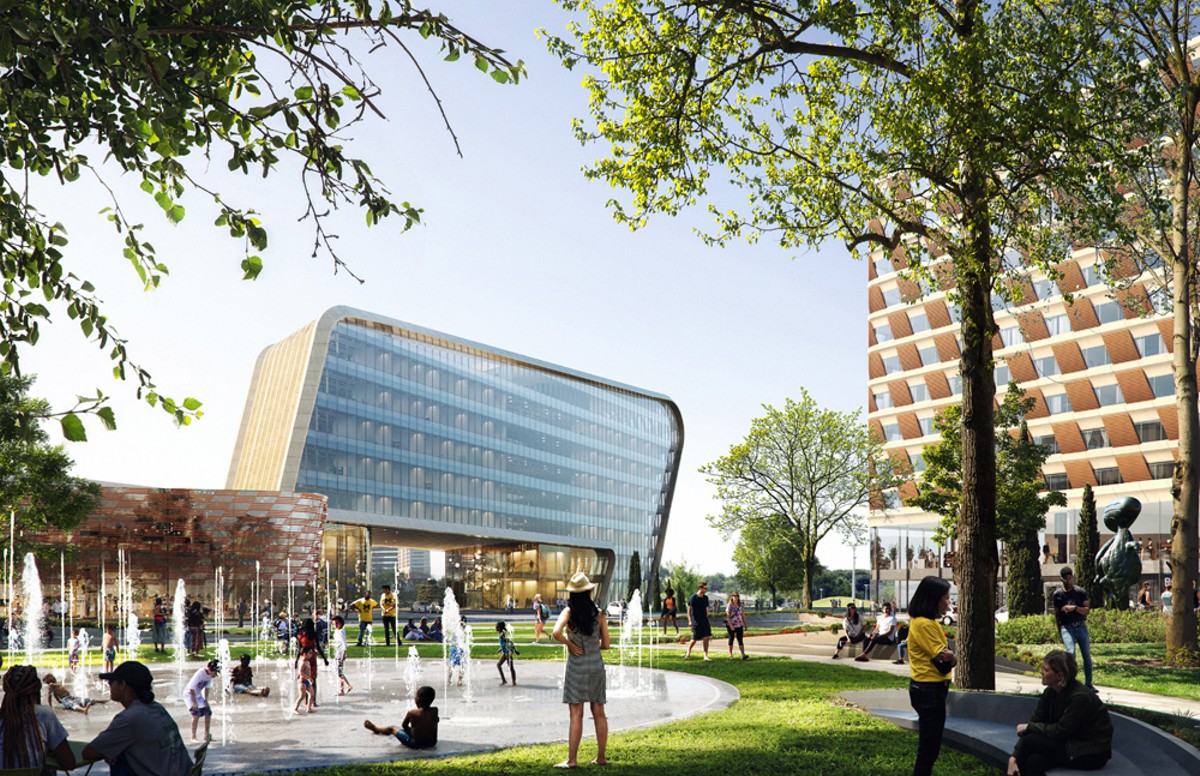By the time PG Watkins heard the news, the wheels were already in motion. Last Oct. 30, the University of Michigan announced it was building a new Center for Innovation on a plot of land that was previously set to become the new Wayne County jail — a project that was scrapped back in 2013 after it ran $91 million over its $300-million budget. In addition to U-M teaching and research, the location will house residential units, a hotel, and an "incubator" for start-ups. The $300-million project is bankrolled by Dan Gilbert and Stephen Ross, men with a combined wealth of almost $16 billion. In the face of fierce grassroots opposition, the County is opting to still build the $533-million, 2,280-bed jail — but far from downtown. As a longtime community organizer who helped form No New Jails Detroit, a coalition demanding divestment from jails and prisons and investment in communities, Watkins is appalled that the County is storming ahead with both projects. "They could've pretended there was a community accountability process," Watkins says. "They didn't even do that."
In announcing the project, U-M promised to uplift Detroit. The Center for Innovation will "diversify" the economy, "partner" with local government, and "engage" schools and community groups, President Mark Schlissel boasted. But all it takes to realize the hollowness of this promise is to walk around the surrounding downtown, where rents shot up 15 percent last year alone. With almost 40% of families living in poverty and thousands of homes without water, a corporate campus and a new jail are not what Detroit needs. Far from an engine of shared prosperity, U-M's Center for Innovation will accelerate inequality, displace residents of color, and waste more of Michiganders' tax dollars — all to sanitize the reputations of two modern-day robber barons. While priding itself on its commitment to diversity, equity, and inclusion, the University of Michigan is steamrolling one of the most marginalized communities in a majority-Black city.
We've seen this before. From a proposed Columbia University gym that set off civil rights protests in Harlem in 1968, to the bulldozing of a historic barrio to make room for university facilities in Claremont, California, to the University of Chicago's ongoing efforts to turn its racially diverse surroundings into a college town, well-resourced universities often assume they know best what communities need. Like these historical antecedents, the Center for Innovation is poised to drop onto the people of Detroit "like some self-contained spaceship from Ann Arbor," as Freep columnist John Gallagher put it. Detroiters are right to wonder how the Center will improve education, make neighborhoods safer, or reduce inequality, which together make up residents' top concerns. For all its pomp, the project's rollout has been short on answers. Click on the "Benefits" section of its sleek new website, and all you'll find is a graphic with all-caps buzzwords like CONNECTIVITY and COLLABORATION — with vague one-sentence descriptions for each.
It's not just that U-M's promise to revitalize Detroit is overblown. The multi-billionaires behind the Center are among the people most responsible for the city's racial and economic inequality in the first place. Gilbert's first fortune came by founding Quicken Loans, the largest online mortgage lender whose practices brought down a $32.5-million settlement with the feds in 2019 for issuing fraudulent loans. (The company claims the loans were the result of human error, and maintains that it was never a major player in the subprime mortgage industry.) As the latest chapter in a long history of lenders profiting off racism, the foreclosure crisis hit Black Detroiters especially hard.And as geographer Brett Story has shown, Gilbert's Bedrock real-estate company gobbled up downtown buildings at a pittance. "[Bedrock] began purchasing buildings in downtown Detroit in 2011, exploiting the 'skyscraper sale' that followed the 2008 financial crisis, which intensified the city’s economic decline almost a generation after shuttered factories and real-estate speculation began pushing prices down and vacancies up," Story writes. Bedrock could then fill the buildings with upwardly mobile (and overwhelmingly white) people flocking to downtown, including the very people his companies now employ in their offices on Woodward Avenue, near the Bedrock-owned Center for Innovation site.
Stephen Ross's real-estate dominance extends much further, with his company behind some of the world's most lavish developments, including New York's Hudson Yards, a planned Manhattan neighborhood that New York magazine called "a grand gift of urban space to the global elite." Gilbert is also the poster boy for abusing state and federal tax incentives — Michigan's legislature handed him $250 million in 2017 and $618 million in 2018, despite the fact that he's the state's richest resident, worth $6.8 billion. U-M is also implicated, with Gilbert receiving a federal tax break for the Center for Innovation site. The tax break was meant for low-income communities, but a ProPublica report found the government modified its list of eligible census tracts after Gilbert's company gave $750,000 to President Donald Trump's Inauguration Committee. (A spokeswoman for Gilbert's Bedrock Detroit says that while the site falls within an eligible census tract for Opportunity Zones, the company has not yet seen any Opportunity Zone benefit for the Innovation Center projects.)
By partnering with Ross and Gilbert, Michigan's flagship public university is not just endorsing urban plunder — it's helping to launder the spoils. Just ask U-M's "Semester in Detroit" program, which enables undergraduates to take courses while interning for a local community organization. The program recently rebuked the proposed Center as "white billionaires" attempting "to 're-imagine' majority-black Detroit ... for their own economic benefit." (This is especially embarrassing, given that President Schlissel's own statement named the program as exemplary of the "ecosystem" U-M's Center will build on.) Simply put, building a "talent pipeline" for the tech, finance, and real-estate industries that made themselves multibillionaires is hardly an act of altruism. Yet such pseudo-philanthropy enables Gilbert to present himself as the Midwest's Warren Buffett, the "Dream Maker of Detroit." Likewise, with the Center for Innovation proposal, Ross is leveraging his status as U-M's largest donor to distract from his controversial fundraising for Donald Trump, with the project website calling him "a devoted philanthropist focused on," among other things, "the creation of more sustainable cities throughout the world."
U-M's announcement paid lip-service to Detroit's heritage, but the Center for Innovation will worsen a long history of elite disregard and community displacement in downtown. As Semester in Detroit pointed out, the Center site is in the former Black Bottom, a majority-Black neighborhood "strategically destroyed" by the construction of the Chrysler Freeway in the 1960s. Black Bottom was part of a national pattern in the 1950s and '60s, as federally funded "urban renewal" projects displaced hundreds of thousands of families. U-M's message today is the same that governments sent to Black Bottom over 50 years ago. "They're telling us that 'People who matter more live [in] other places and need to come down here,'" Watkins says. "They're telling Detroiters that we don't matter. That our lives don't matter."
Proponents claim this is the best that can be done with the "fail jail." County Executive Warren Evans stated that "regardless of what goes on [the] site, it beats the heck out of a jail." Never mind, Watkins says, that Wayne County is still building the jail.
Evans's comment is also an insult to residents' imaginations.
"Detroiters are being told, 'We're going to do this little thing and y'all should just be happy with that," he says. But innovation is not something Detroiters need brought to them. Despite Mayor Mike Duggan's promise to make Detroit a "city for everyone," not much has changed. "I wish someone had built a 'Center for Innovation' back in the day," Watkins says. "I wish the people of Black Bottom were given a chance to be seen as innovators."
Ordinary Detroiters continue to imagine innovative futures, using the very principles that Mayor Duggan and U-M claim to uphold. No New Jails is asking residents how they would invest $500 million in communities instead of a jail. Black Bottom Archives is preserving the very history U-M is ignoring. And at the Detroit Justice Center, mere blocks from the Center for Innovation site, individuals with deep roots are imagining democratic alternatives that meet community needs. These young people are following in the footsteps of countless other "solutionaries," as Detroit civil rights icon Grace Lee Boggs would've called them. From mental-health facilities to a dog park to a restorative justice center, there's no shortage of ideas that "beat the heck out of a jail." In a state that incarcerates 64,000 people, in a County where 70% of people in jail are Black, and in a neighborhood that continues to be overpoliced, delaying the new jail's construction was never going to be enough. Each proposal has one thing in common: the knowledge that Detroit can do better than diverting land to jails and gentrifiers.
David Helps is a Ph.D. student of history at the University of Michigan, as well as a writer and organizer based in Ypsilanti.
Stay on top of Detroit news and views. Sign up for our weekly issue newsletter delivered each Wednesday.






